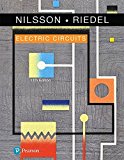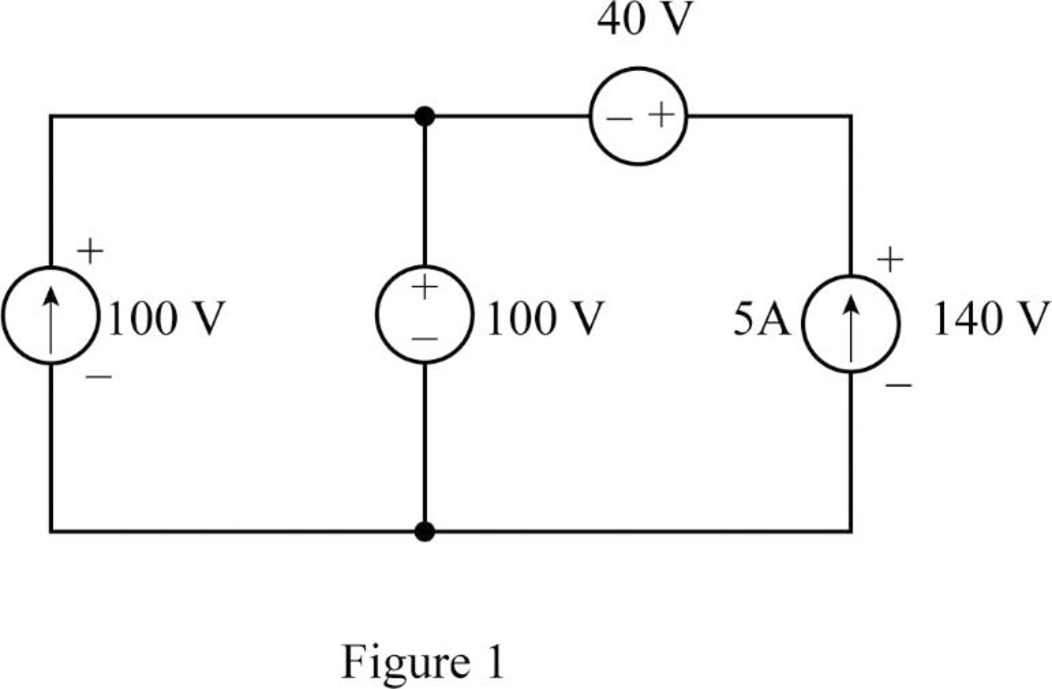
Verify whether the interconnection in the circuit in Figure P2.1 in the textbook is valid or not. Calculate the power developed by the current sources if the circuit is valid. Explain the reason if the interconnection in the circuit is not valid.
Answer to Problem 1P
The interconnection in the given circuit is valid and the power developed by the current sources is 1700 W.
Explanation of Solution
Given data:
Refer to Figure P2.1 in the textbook for required data.
Formula used:
Write the expression for power developed by the source (voltage or current) as follows:
Here,
Calculation:
From the given circuit, it is clear that, the voltage drop across the 10 A current source is 100 V and the voltage drop from the negative terminal of the 40 V voltage source to the bottom terminal of the 5 A current source must be 100 V.
In order to maintain the voltage drop of 100 V from the negative terminal of the 40 V voltage source to the bottom terminal of the 5 A current source the voltage drop across 5 A current source must be 140 V.
From the analysis, redraw the circuit as shown in Figure 1.

All the sources in the given circuit are independent sources. The independent voltage source can carry any current that required by the connection and the independent current source can support any voltage that required by the connection.
From the analysis, the voltage drop across the sources is satisfied. Therefore, the interconnection in the given circuit is valid.
Rewrite the expression in Equation (1) to find the power developed by the 10 A current source as follows:
From Figure 1, current 10 A enters from the negative terminal of 100 V. Therefore, the values of
The negative sign indicates the delivered power by the source. Therefore, the power developed by the 10 A current source is 1000 W.
Rewrite the expression in Equation (1) to find the power developed by the 5 A current source as follows:
From Figure 1, current 5 A enters from the negative terminal of 140 V. Therefore, the values of
As the negative sign indicates the delivered power by the source, the power developed by the 5 A current source 700 W.
Write the expression for power developed by the both current sources as follows:
Substitute 1000 W for
Conclusion:
Thus, the interconnection in the given circuit is valid and the power developed by the current sources is 1700 W.
Want to see more full solutions like this?
Chapter 2 Solutions
Electric Circuits Plus Mastering Engineering with Pearson eText 2.0 - Access Card Package (11th Edition) (What's New in Engineering)
- They are one quearrow_forwardO Draw the four possible negative feedback contigurations of an op-amp. Write the input and output impedances of these configurations in ideal cases. 5arrow_forwardE9.6 Determine the average power absorbed by the 4-2 and 3-2 resistors in Fig. E9.6. 302 j20 Figure E9.3 4Ω ww Figure E9.6 12/0° V j30 -j2 N 13/10° A (+60° V (OEFarrow_forward
- -160 For the P-channel JFET given in the following figure, the IDSS = 2MA a) Determine IDQ and VSDQ b) Determine the source-follower circuit transistor parameters are: Vp = +1,75 V, and λ=0. Small-signal voltage gain, Av = So VDD = 10V R₁ = 90kr Rs =5k CC1 WW R₂ = 110kn 50 C02 BL = 10 kr GNDarrow_forwardNeed a solarrow_forwardI need a drawing on how to connect the function generator, oscilliscope, and both multimeters. It is hard for me to follow text instructions. The function generator has a postive,common and negative. The oscilliscope has chanell A and B, both channels have a postive and a negative. I know you can provide text instruction but a little sketch would be very helpful thank you.arrow_forward
- Don't use ai to answer I will report you answerarrow_forwardQ1/ A three phase, 500 kVA, 6600 V, 50 Hz, 6 pole, star connected synchronous motor has synchronous impedance of J 70 ohm per phase at its normal rating, the motor is excited to give unity power factor at the input terminals. Find a) The rated current and power factor. b) The emf behind the synchronous impedance. c) The developed torque. d) The pull out torque. e) The increase in excitation which will just permit an increase of 30% of rated torque before pulling out of synchronism. (45 M.)arrow_forwardcan you fin Vds and Vgs of all transistors and specify te operating region off all transistors and prove it. 58V 5.8 V 1.8V M2 0.9V 22222 と A 4852 m 3 01 A Voy = 0.2 V V4)=0.SV λ=0.1 V-1arrow_forward
 Introductory Circuit Analysis (13th Edition)Electrical EngineeringISBN:9780133923605Author:Robert L. BoylestadPublisher:PEARSON
Introductory Circuit Analysis (13th Edition)Electrical EngineeringISBN:9780133923605Author:Robert L. BoylestadPublisher:PEARSON Delmar's Standard Textbook Of ElectricityElectrical EngineeringISBN:9781337900348Author:Stephen L. HermanPublisher:Cengage Learning
Delmar's Standard Textbook Of ElectricityElectrical EngineeringISBN:9781337900348Author:Stephen L. HermanPublisher:Cengage Learning Programmable Logic ControllersElectrical EngineeringISBN:9780073373843Author:Frank D. PetruzellaPublisher:McGraw-Hill Education
Programmable Logic ControllersElectrical EngineeringISBN:9780073373843Author:Frank D. PetruzellaPublisher:McGraw-Hill Education Fundamentals of Electric CircuitsElectrical EngineeringISBN:9780078028229Author:Charles K Alexander, Matthew SadikuPublisher:McGraw-Hill Education
Fundamentals of Electric CircuitsElectrical EngineeringISBN:9780078028229Author:Charles K Alexander, Matthew SadikuPublisher:McGraw-Hill Education Electric Circuits. (11th Edition)Electrical EngineeringISBN:9780134746968Author:James W. Nilsson, Susan RiedelPublisher:PEARSON
Electric Circuits. (11th Edition)Electrical EngineeringISBN:9780134746968Author:James W. Nilsson, Susan RiedelPublisher:PEARSON Engineering ElectromagneticsElectrical EngineeringISBN:9780078028151Author:Hayt, William H. (william Hart), Jr, BUCK, John A.Publisher:Mcgraw-hill Education,
Engineering ElectromagneticsElectrical EngineeringISBN:9780078028151Author:Hayt, William H. (william Hart), Jr, BUCK, John A.Publisher:Mcgraw-hill Education,





